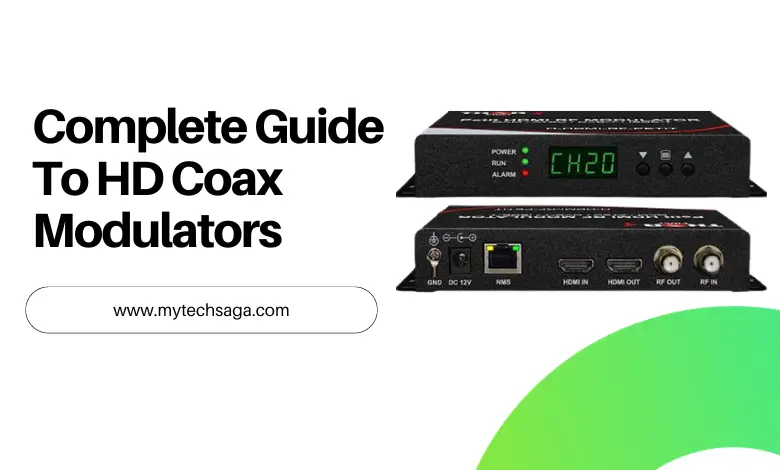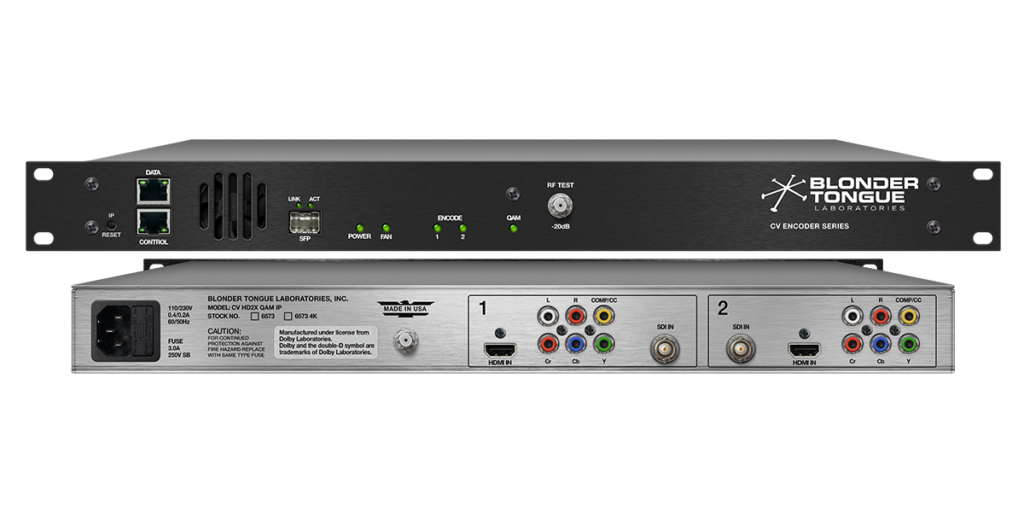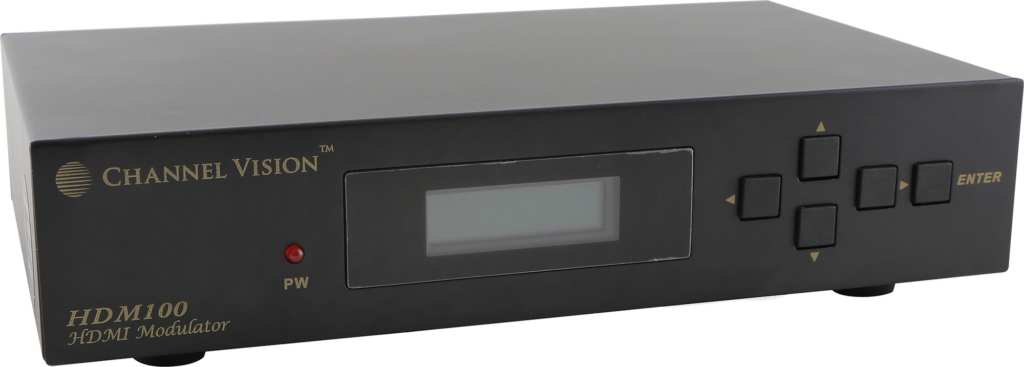Complete Guide to HD Coax Modulators: How They Work, Top Uses, And Best Models

HD coax modulators are invaluable devices that allow you to transmit high-definition audio and video signals over long distances using coaxial cables. This comprehensive guide will teach you everything about HD coax modulators, from key benefits to real-world applications.
Table of Contents
Introduction
An HD coax modulator is a device that accepts HDMI, component, composite, S-video, and other high-definition audio/video signals as input. It then converts those digital signals into analog RF radio frequencies that can be transmitted long distances over an existing coaxial cable infrastructure.
Multiple television sets connected to the coaxial network can pick up the modulated RF signal, allowing you to distribute stunning 1080p HD video and audio to any display in your home, office, or commercial installation using just a single coax cable line.
HD coax modulators provide an affordable and convenient solution for sending HD programming from Blu-ray players, streaming devices, cable boxes, and other sources to multiple televisions without needing expensive HDMI cabling to each display.
They are easy to install, integrate into existing coax networks, and enable crystal clear HD distribution at a fraction of the cost of separate HDMI runs. This guide will cover everything you need to know about HD coax modulators, including how they work, key features to look
for real-world applications, installation and troubleshooting tips, and top products on the market.
How Do HD Coax Modulators Work?

HD coax modulators leverage RF modulation technology to encode HD video and audio signals from an HDMI, component, or other digital audio/video source into radio frequencies transmitted over coaxial cabling. Here is an overview of how the process works:
- The modulator receives digital A/V signals from a media source like a Blu-ray player via HDMI, component, composite, or S-video connections.
- An internal encoder converts the digital video and audio into an analog RF television signal. This encoding process is called modulation.
- The newly modulated RF signal contains the source media content but in a format that can be carried over coaxial cable.
- Multiple modulated RF channels can be transmitted through the same coax without interference using different frequencies.
- Televisions connected to the coax network can tune to the proper channel frequency to receive the modulated HD signal back into full HDMI quality video and stereo audio.
- A single modulator can drive multiple TVs simultaneously by splitting the coax line—no need for separate cables back to the source for each display.
This digitally modulated RF transmission enables the distribution of stunning 1080p HD video to any TV on the coax network with a single centralized modulator.
Key Benefits of HD Coax Modulators
Many benefits make HD coax modulators useful in both residential and commercial contexts:
Distribution of HD Video over Coax
The core benefit is the ability to distribute HD video from Blu-ray, media players, cable boxes, and an existing coaxial cable infrastructure. There is no need for dedicated HDMI runs to each display.
Leverage Existing Coaxial Cabling
Tap into coaxial cabling that already runs through walls and ceilings. Avoid the hassle and expense of pulling new cables for HD distribution.
Affordable Multi-TV HD Expansion
Upgrade additional TVs to high-definition programming without buying additional receivers. The modulated network provides distribution.
Long Distance Transmission
Coaxial cable allows reliable transmission at distances over 150 feet with minimal signal degradation when using high-quality RG6 cable.
Plug-and-Play Installation
Most modulators are plug-and-play with automatic channel scanning and easy mounting. No configuration is needed.
Mix HDMI and coaxial Sources.
It blends modern HDMI sources seamlessly with existing coax cabling, so you don’t have to replace complete infrastructure. For residential and commercial applications, these benefits add significant time and cost savings while still delivering stunning HD video quality.
Key Features to Look For
When shopping for an HD coax modulator, keep an eye out for these key features:
HDMI Input
An HDMI input lets you connect Blu-ray players, streaming boxes, game consoles, and other devices. Prioritize HDMI v1.4 or higher.
HD Resolutions
Ensure the modulator supports full 1080p and even 4K resolution to take advantage of ultra-high definition sources.
Number of RF Channels
More RF channel outputs allow distribution to more TVs from a single modulator. Look for at least 4-8 channels.
CATV Frequencies
Support for TV broadcast channel frequencies allows mimicking cable/antenna channels for a familiar channel experience.
Remote Control Pass-Through
Lets IR remote control signals pass through to control media player volume/channels. Convenient feature.
On-Screen Display
An OSD makes it easy to configure channels and view the status on a connected TV during setup.
Automatic Channel Scanning
Choose a modulator with auto-scanning to quickly detect used channels and allocate empty ones on the network—Simplifies setup.
Real-World Applications
There are many practical applications for HD coax modulators, both in homes and businesses:
Home HT Distribution
Distribute Blu-ray players, media PCs, and cable/satellite boxes to multiple TVs via coaxial home wiring.
Bars & Restaurants
Bars, restaurants, and gyms can broadcast HD programming from satellite boxes or media players to all displays over coax cabling.
Hotels
Hotels can share a single central HD cable box/DVR with all rooms without running HDMI to each room, lowering costs.
Office Conference Rooms
Route laptop/tablet HDMI presentations to wall-mounted displays over office coax networks. Clean installation.
Digital Signage
Retail stores can distribute media player content to multiple displays on the sales floor using only coax.
Educational HD Sharing
Using existing coaxial infrastructure, schools can cost-effectively share HD educational programming with classroom displays.
Surveillance DVRs
Use existing coax cabling to route HD surveillance camera feeds to monitors in offices or security rooms.
The possibilities are vast for both residential AV setups and commercial applications that need to drive multiple HD displays over a distance.
Top 8 HD Coax Modulators
Based on features, performance, and overall value, here are 10 of the best HD coax modulators currently available:
1. ViewHD VMOD-HDMITX-1CH

- 1080p HDMI input/output with 1 channel RF coaxial output
- Supports HDTV resolutions up to 4K
- HDCP 2.2 compliant
- Affordable plug-and-play performance
2. Antronix MMC100+

- HDMI, component, composite inputs with 4 RF outputs
- GUI for configuration
- CATV compatible frequencies
- Remote control pass-through
3. Blonder Tongue QAM425-HD

- Commercial-grade performance
- 8 RF channel outputs
- Optional rack mounting is available
- Optimized for cable TV installations
4. Channel Vision HD-MOD-QAM

- Supports HD resolutions up to 1080p
- 4 RF channel outputs
- Automatic channel scanning function
- Affordable pricing
5. NXG NX-HDMIB-8

- HDMI input with 8 RF channel outputs
- Rack mountable (1RU)
- GUI for channel configuration
- Remote control pass-through
6. Cables To Go Trulink 4-Play

- HDMI & 3.5mm audio input
- 4-channel RF coaxial output
- Compact and affordable
7. Cobalt HDMI To Coax

- HDCP 2.2 compliant
- Resolutions up to 4K
- WebGUI for management
- Professional quality
8. GE 33841 HDMI Coax Adapter

- HDMI input with single coax output
- Resolutions up to 1080p/60
- Plug-and-play installation
- Compact and portable
This list covers various models at different price points, features, and performance capabilities to suit basic and professional needs. Be sure to match modulator capabilities to your specific cabling infrastructure, source devices, and TV/display requirements.
Key Installation Tips
Proper installation is important for achieving optimal performance from your HD coax modulator. Follow these tips:
- Place the modulator near your HD media sources for short cable runs to those devices.
- Connect sources like Blu-ray players using HDMI for best quality digital transmission.
- Split the RF coaxial output to feed all your connected TVs. Use a powered splitter for best results.
- Label your RF output cables clearly so you know which run feeds each television.
- Use high-quality RG6 coaxial cable and avoid excessive splitting for the best HD signal strength.
- Connect TVs to the RF feed using only the coaxial input to receive the modulated HD signal.
- Perform a channel scan on TVs once connected so they detect the new modulated HD channels.
- Test reception on all TVs and splitters to ensure crystal clear picture and sound.
Following professional installation, best practices help deliver flawless HD video to all your displays over the coaxial network.
Troubleshooting Tips
If you experience issues getting your HD coax modulator working optimally, try these troubleshooting tips:
No signal or picture on TVs
- Re-scan TVs for channels in case the modulator changes frequencies
- Check coaxial connections and splitters for loose fittings
- Verify that the modulator has power and that the source device is on
Poor picture quality
- Use higher quality RG6 coax and minimize splits
- Adjust source resolution if the TV doesn’t support it natively
- Increase channel bandwidth on the modulator if available
No/low audio
- Verify audio output settings on source match modulator input
- Check TV audio settings and volume
- Try different compatible digital audio inputs
Remote not working
- Ensure remote supports RF frequencies used
- Change remote battery
- Enable pass-through on the modulator
Overheating
- Ensure proper ventilation around the modulator
- Avoid stacking equipment tightly
- Move the modulator away from heat vents
Calling the modulator manufacturer’s tech support line can help diagnose and fix more stubborn issues.
Frequently Asked Questions
Can I play protected content?
Yes, most modulators are HDCP compliant, allowing playback of protected content like Blu-rays.
Do I need a receiver for each TV?
No, the whole point of a modulator is to distribute HD signals to multiple TVs without needing a box on each one.
Is special wiring required?
No, you can use standard RG6 coaxial cabling that is likely already run through your home or office walls.
Can I mix HDMI & coax sources?
Absolutely. Many people combine HDMI Blu-ray players with coax-connected cable boxes/DVRs. The modulator bridges both worlds.
Conclusion
After reading this guide, you should completely understand what HD coax modulators are, why they are helpful, their real-world applications, and how to select the suitable model to meet your needs. The ability to inexpensively distribute stunning 1080p and even 4K video to multiple televisions over existing coaxial cabling makes these devices extremely valuable in homes and commercial environments.
Carefully match desired features like HDMI input, number of RF channels, automatic scanning, and remote pass-through to your specific installation requirements. With the suitable modulator properly installed, you can enjoy flawless high-definition video distribution to every display in your home or facility at a fraction of the cost of direct HDMI cabling.
Take your home theater or business A/V system into the future and start experiencing the benefits of HD video distribution over coax today!




